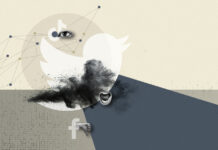
When Erró receives letters sent to his studio, they almost always contain snippets from comics and magazines. Selected by complete strangers, the Icelandic artist said in an interview some time ago. But all of these senders are familiar with Erró’s visually stunning empire – and their finds should enrich it with a few more motifs.
Erró, whose real name is Gudmundur Gudmundson and is celebrating his 90th birthday today, cannot complain about a lack of ideas even without the external supporters. All the drawers in his Parisian studio are full of material, and the collage-like paintings hardly seem to have room for even one more figure.
They stream towards the viewer from all sides, throw themselves at him, swell out of the chaos of super forms: Hulk, Marilyn Monroe, Spiderman, the spaceship Enterprise, Wonder Woman.
With such a repertoire one usually ends up in the popular genres. But Erró has achieved international fame with it, his works hang in the Frankfurt Schirn Kunsthalle as well as in the Center Pompidou in Paris or the Blue Chip Gallery Perrotin, which regularly exhibits him in their New York rooms.
The painter doesn’t even stop at his colleagues and integrates figures into the sometimes monumental hidden objects that could also have come from Picasso or Fernand Léger.
Erró, however, one forgives even this plagiarism. If only because his art represents a single accumulation of quotations from the global pool of images. It has a system, is the dominant characteristic – and illustrates how most people feel in the midst of the daily flood of impressions.
Before Erró went to the Art Academy in Reykjavík in 1952 and then to Oslo, he lived on an Icelandic farm. You can imagine how extreme the change was. How comics and consumerism swept over the students who had grown up in rural idylls like a wild whirlpool. Basically, he continues to recreate this moment to this day, his subjects are a single agglomeration of impressions.
Erró later worked on mosaics in Florence, in 1958 he moved to Paris and two years later took part in the exhibition “L’Anti-Procès”, which saw itself as a manifesto against the Algerian war. This is also part of his world view: in contrast to many representatives of Pop Art, to which Errós is attributed, his figurative panoramas also see themselves as criticism of political and social situations.
In 1967, for example, in the painting “American Interior No. 6”, which is in the collection of Cologne’s Museum Ludwig, placed Ho Chi Minh in the bedroom of an American family, exposing the fear of North Vietnam’s invasion of the land of opportunity.
Such contrasts fuel Erró’s work throughout the ages. “Politics expands the possibilities of painting. The only permanent revolution—constant change—progresses,” he wrote in 1970. This is still true today.

















